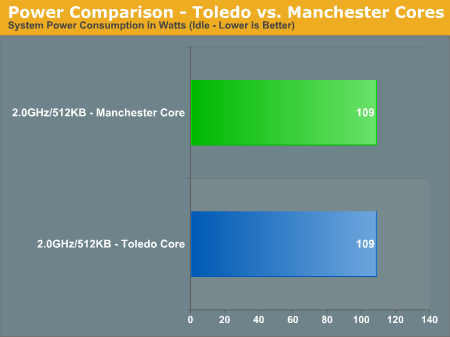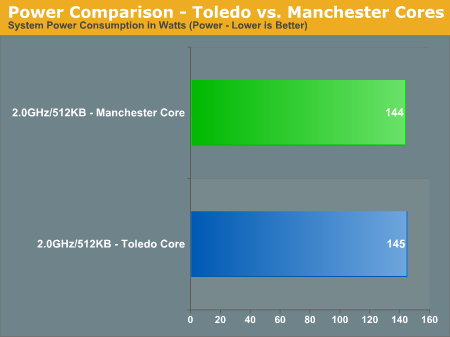Affordable Dual Core from AMD: Athlon 64 X2 3800+
by Anand Lal Shimpi on August 1, 2005 9:36 AM EST- Posted in
- CPUs
Power Comparison: Manchester vs. Toledo
In our first review of the Athlon 64 X2, we were astounded by the fact that the fastest Athlon 64 X2, thanks to its cool running 90nm process, consumed less power than any single core Pentium 4 processor, not to mention all of the dual core models.We also noted that a dual core Athlon 64 X2 processor used less power than a single core 130nm Athlon 64, once again a testament to AMD's transition to 90nm.
This time around, we're interested in the power consumption benefits of the new Manchester core. AMD says the core drops the maximum power consumption from 110W down to 89W, but what is that in the real world?
In order to find out, we performed one simple test; we clocked an Athlon 64 X2 4200+ based on the old Toledo core at 2.0GHz, the same clock speed as the X2 3800+, and measured the total power consumption of the system. We then swapped out the Toledo based X2 for a new Manchester based X2 to see, clock for clock, what the tangible decrease in power consumption was.
Remember, we're only looking at total system power consumption - obviously CPU power consumption will be a lot lower, but with identical system specifications, the CPU's impact on power consumption should be the major variable that we're measuring here.












109 Comments
View All Comments
dougSF30 - Monday, August 1, 2005 - link
No, in that Toledo die can have 1/2-cache disabled, and run as 512K L2 x 2However this page is silly for other reasons-- they probably had a Manchester 4200+, not Toledo, and more importantly, it just shouldn't make any difference, as the 89W TDP is given to both Toledo and Manchester 4200+s. They are both Rev E parts, and with equal frequency and enabled cache size, should on average be almost identical, as not much changed from E4 to E6.
dougSF30 - Monday, August 1, 2005 - link
This whole page should go.(1) Your 4200+ was probably a Manchester part, not a Toledo
(2) Toledo vs. Manchester doesn't really matter in terms of power. Rev E4 and E6 are basically the same. AMD is simply able to choose a lower official TDP for the lower-rated parts (4200+ and 3800+), whether they are made from the Manchester die OR the Toledo die. (Both 4200+ "BV" and 4200+ "CD" receive an 89W TDP from AMD, along with the new 3800+ "BV")
Doormat - Monday, August 1, 2005 - link
If I had the money. Surely though, this is a great value and I can see people getting this chip (and subsequently OCing it to 2+GHz). Mainstream performance is about to get a kick in the pants.dougSF30 - Monday, August 1, 2005 - link
All the updates fixing the '4200+/4600+ were already manchester' issue just vanished...Houdani - Monday, August 1, 2005 - link
Page 5. Third table.This table shows AMD with higher numbers in 3 out of 4 benches, yet AMD is given the win in all 4. Did Intel get shafted by the math here? Perhaps the D830 managed to eke out 2 wins overall?
Yes, yes. Nitpick. Just keeping you honest.
Also (page 1) was AMD really late to the desktop dual core scene? While Intel did announce earlier, availability-wise weren't both companies on par?
SDA - Monday, August 1, 2005 - link
Higher numbers do not equal higher performance in all of these tests. To quote the review (what, didn't you see the caption?): "The iTunes scores are Encoding Times in Minutes, lower numbers are better."And no, Intel's dual-cores were definitely available before AMD's. I distinctly remember hearing a lot of complaints about this. The gap doesn't seem that big in retrospect, but trust me, it was there.
Houdani - Monday, August 1, 2005 - link
captions = goodAgreed -- sometimes higher is better (frames) and sometimes lower is better (time). So in that regard, wouldn't all the encode tests (and 3dsmax) be measured in time? If so, then AMD would have lost 3 of the 4, rather than the other way around. Gah!
What am I missing here .. are the Windows Media Encoder HD and the Divx 6 Encode measured in some other way besides time?
SDA - Monday, August 1, 2005 - link
No, not all are measured in time. If that were the case, it would have been stated, I'd think.Video encoding can also be measured in frames encoded per second. It usually IS measured that way, because that way higher == better (as our minds tend to think).
dougSF30 - Monday, August 1, 2005 - link
Or at least, I noticed it back on July 12 on AMD's quick reference guide. Both BV and CD.coomar - Monday, August 1, 2005 - link
the intel memory was rated at 3-3-3@533, thats pretty good, i think the lowest you can go on ddr2 is 3-2-2@533, but that would be a lot more than 2-2-2@200 ddr ram, isn't the intel board still 50 bucks more than the amd 939 boards, then the x2 3800 would be a compeititor with the 2.8 p-d but only for a month or two until they get the prices down on the new intel chipsetsthough ddr2 seems to have an easier time with larger ram modules, 1gb modules in particular
i'll be interested in the overclocking of this chip